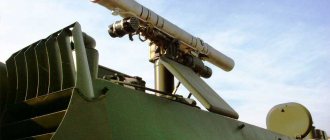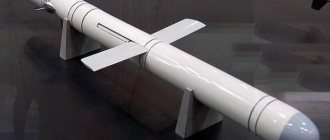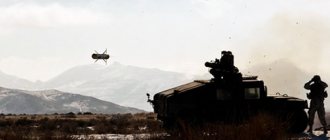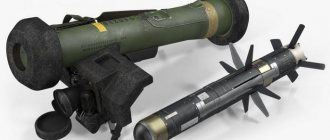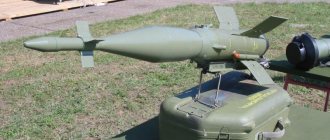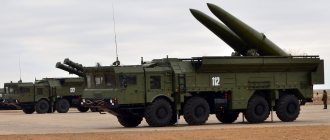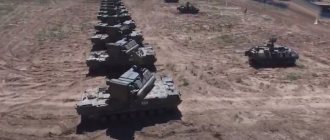Self-propelled ATGM 9K114 "Sturm-S" at the Chebarkul training ground. 2010 |
In the 1970s, as part of work on second-generation anti-tank missile systems (ATGMs) at the Mechanical Engineering Design Bureau in Kolomna under the leadership of S.P. Invincible, a unique long-range ATGM “Sturm” was developed.
The complex was created as self-propelled ("Shturm-S") and helicopter-mounted ("Shturm-V") with a single missile, common bases for constructing a control system and the maximum degree of equipment unification.
IDEOLOGY OF "STORM"
Like almost all second-generation ATGMs, Shturm provides semi-automatic missile guidance to the target. Its main differences from most of its contemporaries were the supersonic flight speed of the rocket and the associated transmission of control commands via radio channel. The absence of a cable trailing behind the missile made it possible to increase the missile's flight speed to 510 m/s (for an ATGM with a wire line - up to 300 m/s), the firing range - to 5000 m, which facilitated its use in self-propelled and helicopter versions. In the USA and NATO, the complex was given the designation AT-6 Spiral.
Diagnostics
Diagnosis of panic disorders includes a whole list of examinations that are necessary to confirm the primary pathology and exclude other possible diseases.
Diagnosis of panic disorders is always carried out comprehensively
Differential diagnosis
In order for a patient to be diagnosed with “vegetative crisis or cardioneurosis” (VSD with a crisis course), it is important to carry out not only a primary diagnosis, but also a differential diagnosis with other diseases that may manifest similar symptoms. These may be the following pathologies:
- hyperfunction of the thyroid gland;
- malignant hypoglycemia (low blood glucose levels);
- bicuspid heart valve prolapse;
- organic mental pathologies.
It is mandatory to conduct a blood test for sugar, ultrasound of the thyroid gland, and ultrasound of the heart. The patient is also advised to consult a psychotherapist, neurosurgeon and neurologist.
Basic examination
Since treatment of panic attacks always includes therapy for the underlying disease, if cervical osteochondrosis is suspected, diagnosis may include the following examinations:
ROCKET AND GUIDANCE EQUIPMENT
The 9M114 ATGM ("Cocoon") is made according to the aerodynamic "duck" configuration with front-mounted rudders and a folding cross-shaped rectangular wing. The missile is equipped with a dual-mode solid propellant propulsion engine, a undockable monoblock cumulative warhead, and a turbogenerator power source. In the tail section there is an instrument compartment, an antenna and a pulsed source of infrared radiation, which is used to track the position of the missile with guidance equipment. The ATGM is stored in a fiberglass transport and launch container (TPC), and is launched from the TPK using a booster engine. During flight, the rocket rotates, which makes it possible to control it using a single-channel scheme.
| The tail section of the 9M120 ATGM and the transport and launch container. |
The microwave radio control channel is organized between the command-encoder unit of the guidance equipment placed on the launcher and the decoder-executive unit of the ATGM. Reliability and noise immunity of the command line, as well as the possibility of simultaneous operation of several complexes, are ensured by signal coding, its high-quality selection, a “narrowed” range with five letter frequencies, and a narrow antenna radiation pattern. The minimum firing range is a bit long - 400 m, but an ATGM of this class is not intended to engage targets at close ranges. Subsequently, the complex was replenished with the 9M114F missile (high-explosive, with a thermobaric warhead) and 9M114M with a tandem warhead to destroy tanks with dynamic protection. The complex can also be used to destroy bunkers, bunkers (in Afghanistan, “Sturms” successfully hit firing points and fortifications of dushmans), as well as hovering helicopters.
Treatment: methods and drugs
Treatment methods for panic attacks in cervical osteochondrosis depend not only on the severity of panic disorder and the root cause of its occurrence, but also on concomitant disorders and pathologies. For example, moderate vegetative-vascular disorders that occur against the background of compression of the cervical blood vessels can be treated quite successfully without the use of drugs from the group of psychotropic substances and tranquilizers. At the same time, episodic paroxysmal anxiety associated with organic brain lesions requires specific therapy in a neuropsychiatric hospital.
Drugs
Medicines are the most effective way to quickly cope with an attack and normalize a person’s emotional state, but it is important to understand that it is necessary to approach the treatment of pathology in a comprehensive manner. If the underlying disease that caused the panic attack (osteochondrosis of the cervical spine) is not treated, the attacks will recur more often, and their intensity and duration will increase.
Medications are the most effective way to quickly cope with panic attacks
Taking into account the existing symptoms and identified pathologies, the drug treatment regimen may include the following drugs:
- sedatives of plant origin (valerian, motherwort tincture, mint drops);
- antidepressants (Fluoxetine, Pyrazidol, Nialamid);
- tranquilizers (Diazepam, Atarax, Spitomin);
- B vitamins in the form of intramuscular injections (“Neurobeks”, “Milgamma”);
- B vitamins in combination with magnesium in the form of tablets and capsules (Magnelis, Magne-B6).
To eliminate the cause of panic disorder, chondroprotectors (Teraflex, Dona), centrally acting muscle relaxants (Sirdalud, Mydocalm) and microcirculation correctors (Trental) are used.
The drug Sirdalud
Under no circumstances should you take drugs from the group of antidepressants and tranquilizers without a doctor’s prescription, since in the absence of significant indications, this can lead to severe disorders of the central nervous system, as well as depression of cardiac and respiratory function. If an attack occurs for the first time, at home you can use mild sedatives (Tenoten, Novo-Passit), herbal teas (mint, chamomile, linden) and other safe methods (for example, audiotherapy).
Release form of the drug Novo-Passit
Important! If valerian infusion does not help cope with fear and normalize heart rate, the use of phenobarbital-based medications (Corvalol, Valocordin, Valoserdin) is allowed. For one use, 25-30 drops are enough for an adult. They need to be dissolved in 50 ml of water and drunk before or after meals. You should not use this group of products without consulting a doctor more than 2-3 times (only as an emergency aid).
Drops Valoserdin
Psychotherapy and hypnosis
Cognitive therapy methods are currently recognized as the most effective in the treatment of panic disorders, including panic attacks complicated by neurotic pathologies and disorders. The essence of the method is to influence a person’s subconscious and detailed study of situations and images that cause a panic attack (effective for treating situational panic attacks, that is, associated with a specific situation).
Quick help for panic attacks
Removing a functional block that prevents the patient from getting rid of the fear of death under certain actions or circumstances is also practiced with the help of hypnosis. There is no sufficient evidence base for the effectiveness of hypnosuggestive psychotherapy. But the positive experience of managing such patients confirms the fairly high effectiveness of hypnosis in treating patients with panic attacks of various etiologies.
CARRIERS
The 9K113 Shturm-V complex, adopted in 1976 as the armament of the Mi-24V combat helicopter, replaced the Phalanx complex of the previous generation. The helicopter carried four ATGMs, after modernization in 1986 - up to 16. "Sturm-V" can also be used as part of the armament of the Mi-28 combat helicopter and the Ka-29 transport and combat helicopter. The self-propelled version of the 9K114 Shturm-S ATGM was put into service in 1979 and is built on the chassis of the MT-LB tracked armored personnel carrier. The combat vehicle carrying the Sturm-S received the index 9P149. Its weight is 12 tons, speed is up to 60 km/h on land and up to 6 km/h afloat.
The ATGM guide is mounted on a lifting rod at the rear of the vehicle, the guide's vertical pointing angles are from -5° to +15°, horizontally - 85° to the right and left. After launch, the next ATGM is automatically supplied to the guide through the hatch in the roof from a revolving magazine that can accommodate 12 ATGMs. A periscope sight and guidance equipment are mounted in front instead of a machine-gun turret. Automation of reloading made it possible to reduce the crew of the Sturm-S to two people and achieve a rate of fire of 3-4 launches per minute. The location of the guide and guidance devices, the low height of the vehicle (1.8 m) allow firing from cover. Firing begins from a distance greater than the effective firing range of tank guns, while the relatively short flight time of the ATGM to the target (14.5 s - at 5000 m, 7.5 s - at 3000 m) makes it difficult for the enemy to counter the calculation of the complex.
Links[edit]
- ^ a b "Anti-tank missile systems". KOE mechanical engineering design bureau
(in Russian). Retrieved July 18, 2014. - ^ abc "Plant named after. V. A. Degtyareva: Rocket 9M120 (9M120F) Attack". Open Joint Stock Company "Plant named after
.
V.A.
Degtyarev" . Retrieved July 18, 2014. - ^ a b c d "9M120 ATAKA-B". airwar.ru
(in Russian). Retrieved July 18, 2014. - ^ abcd "SIPRI Arms Transfer Database". Stockholm International Peace Research Institute
. Retrieved July 18, 2014. - Hull, A. W.; Markov D.R.; Zaloga, S. J. (1999). Soviet/Russian practice in armored vehicles and artillery design from 1945 to the present
. Darlington Production. ISBN 1-892848-01-5. - https://www.airrecognition.com/index.php/archive-world-worldwide-news-air-force-aviation-aerospace-air-m military-
defence-
industry/
global
-defense-
security-
news/2019-
news -aerospace-industry-air-force/march/4909-news-feed-russia-s-modernized-mi-28nm-attack-Helicopter-to-get-new-guided-missile.html - "Uralvagonzavod - Terminator fire support combat vehicle". Uralvagonzavod
. Archived from the original on June 25, 2014. Retrieved July 5, 2014. - “Ataka-T guided weapon complex | JOINT STOCK COMPANY RESEARCH AND PRODUCTION CORPORATION MECHANICAL ENGINEERING DESIGN BUREAU."
- “BMP-3M with anti-tank guided missile Ataka 9M120-1 Army-2017 12508172 | Daily report on news coverage of the exhibition "Army-2017" | Defense Security Exhibition Daily News Category 2017".
- “Army 2022: Russian Helicopters present a new modernization of the Mi-24 | Jane 360".
- https://www.lematindz.net/news/4644-des-helicopteres-russes-pour-lalgerie.html
- Akramov (May 17, 2018). "Mi171 update en tueur de char pour l'Algérie". MENADEFENSE
(in French). Retrieved December 19, 2022. - "Archival copy". Archived from the original on March 3, 2016. Retrieved November 15, 2015.CS1 maint: archived copy as title (link)
- https://airrecognition.com/index.php/focus-analysis-photo-report-aviation-defence-industry/aviation-defence-industry-technology/5625-analysis-belarus-receives-two-first-su-30sm - fighters.html
- https://www.janes.com/article/89602/indian-air-force-orders-russian-made-anti-tank-missiles-for-usd29-million
- http: //www.m
military-today.com/missiles/ataka.htm
"ATTACK" COMPLETES "STORM"
| Mi-24V helicopter of the Polish Army Aviation with two Sturm ATGMs. |
In the early 1990s, the Mechanical Engineering Design Bureau presented a significantly modernized complex with the new 9M120 Ataka missile, designed to destroy tanks, reinforced concrete and armored structures, bunkers, bunkers, low-flying low-speed targets, boats and other surface targets. The maximum flight speed of the ATGM is 550 m/s. In addition to the increased firing range, the Ataka is distinguished by a reinforced warhead. The tandem warhead of the ATGM ensured the detonation of dynamic protection elements and armor penetration behind it of 800 mm. The telescopic design of the warhead made it possible to keep the dimensions of the missile with the TPK the same. In the USA and NATO, the designations AT-9 and Spiral-2 are adopted for the “Attack”. “Attack” can be placed on a 9P149 combat vehicle (12 pcs.), a tank support combat vehicle (4 pcs.), as part of the “Sturm-VM” complex - on modifications of the Mi-24, Mi-8, Ka-29 helicopters (8 pcs.), Mi-28 and Ka-52 (up to 16 pcs.). Modification of the self-propelled ATGM "Sturm-SM" and the helicopter "Sturm-VU" involves the introduction of a surveillance and sighting system with television and thermal imaging channels and an additional laser beam control channel for the ATGM. The launcher is also presented in the form of a universal combat module. Boats can be armed with the multifunctional Sturm complex with 9M114 and 9M120 missile variants.
In the 1990s, modernization of the complex continued. The 9M120F missile received a warhead with increased high-explosive action, while the 9M120 received a fragmentation warhead with ready-made fragments and a proximity fuse for hitting air targets. The firing range of the 9M120D ATGM has increased to 10,000 m.
(The article was prepared for the portal “Modern Army” © https://www.modernarmy.ru based on materials from the encyclopedia “Armed Forces of the World”. When copying the article, please do not forget to put a link to the source page of the portal “Modern Army”).
Development[edit]
The AT-9 missile was developed by the Kolomna Design Bureau located in Kolomna. [1] This company has already developed previous ATGMs, such as the AT-3 "Sagger" and AT-6 "Spiral" missiles. Design work began in the mid-1980s. The Ataka ATGM was developed as a successor to the AT-6 Spiral, introduced in the late 1970s. The AT-9 is a further development of the AT-6. Compared to its predecessor, the AT-9 is more resistant to electronic countermeasures, has greater accuracy and has a longer range. The newly developed warhead provides increased armor penetration and effectiveness against explosive reactive armor. The first units were delivered to the Soviet armed forces in 1985. [5]
In the West, this missile is often confused with the 9A4172 Vikhr multipurpose laser beam missile installed on Kamov helicopters and Sukhoi attack aircraft (as well as on some Ukrainian modernized Mi-24/35). These systems are completely unrelated by design and are in fierce competition. As a result of the military operation in Syria, new lightweight multifunctional guided missiles with increased range - up to 15 kilometers - were developed and received for Russian combat helicopters. [6]
Symptoms of a panic attack
- hyperhidrosis (excessive sweating);
- muscle tremors, chills;
- tachycardia;
- dystonic or physiological tremor;
- hot flashes (instant sensations of heat);
- asphyxia (suffocation);
- dyspnea (difficulty breathing, shortness of breath, feeling of lack of air);
- irradiation of pain to the left side of the chest;
- nausea, urge to vomit;
- abdominal pain syndrome (stomach pain);
- sensation of a foreign body, coma in the throat;
- paresthesia (tingling in the limbs, feeling of numbness);
- lightheadedness, dizziness;
- stool disorders (constipation, diarrhea);
- dysbasia (gait disturbance);
- high blood pressure;
- impairment of vision and/or hearing;
- frequent urination.
- derealization (feeling of unreality, alienation, indistinctness of the surrounding reality);
- fear of schizophrenia, obsessive fear of going crazy, losing control over one’s actions;
- disorientation, confusion;
- depersonalization (the patient perceives his actions as if from the outside and feels that he cannot control them);
- interrupted sleep, insomnia (insomnia), nightmares;
- Thanatophobia (fear of death).
- more frequent repetition of attacks with the appearance of new symptoms;
- isolated attacks;
- the addition of depressive symptoms (sleep disturbances, loss of appetite, persistently depressed mood);
- constant fear for your health;
- refusal to perform habitual life rituals (patients stop traveling in public transport, going outside, and their performance sharply decreases).
What does a person experience during a panic attack?
- feeling of fear of varying strength;
- feeling of impending danger;
- fear of death;
- stiffness reaching the point of stupor (in some people);
- motor activity (in others);
- fear of committing an uncontrollable act;
- fear of going crazy;
- confusion of thoughts;
- unreality of what is happening;
- loss of orientation in personality, space and time.
Physical symptoms of a panic attack
The main reason for their appearance is the release of biologically active substances (norepinephrine and adrenaline) into the blood in large quantities. Mediators have a stimulating effect on the nervous, respiratory systems, heart and blood vessels.
- Rapid breathing and heart rate.
- Shortness of breath, lack of air.
- Chills.
- Dry mouth.
- Increased sweating.
- Weakness, body numbness, dizziness.
- Diarrhea.
- Involuntary urination.
- Vomit.
The most pronounced physical symptoms are in anxiety, which develops due to pathology of organs and systems.
Bottom line
Time passes, technology is modernized. The world's leading armies are adopting or are already in service with technical countermeasures against anti-tank systems.
The use of optical-electronic signal suppression leads to a decrease in the efficiency of the control circuit on second-generation missiles. But they are being replaced by new models of weapons, with a control system more protected from various types of interference and the most powerful tandem-type shaped charges.
This allows you to confidently and reliably hit targets with dynamic protection and upgraded armor.
Specifications
Below are the performance characteristics of the Fagot anti-tank guided system.
| Rockets | 9M111 | 9M111M |
| Firing range, m | 70-2000 | 75-2500 |
| Rate of fire, rds/min. | 3 | 3 |
| Average speed, m/s | 186 | 180 |
| Maximum flight speed, m/s | 240 | 240 |
| Dimensions, mm: | ||
| - caliber | 120 | 120 |
| - length | 863 | 910 |
| - wingspan | 369 | 369 |
| Container dimensions, mm: | ||
| - length | 1098 | 1098 |
| - width | 150 | 150 |
| - height | 205 | 205 |
| Rocket mass, kg: | ||
| - in TPK | 13 | 11,3 |
| - without TPK | 13,2 | 11,5 |
| Warhead weight | 2,5 | 2,5 |
| Armor penetration, mm | 400 | 460-500 |
| Armor penetration (60°), mm | 200 | 230 |
